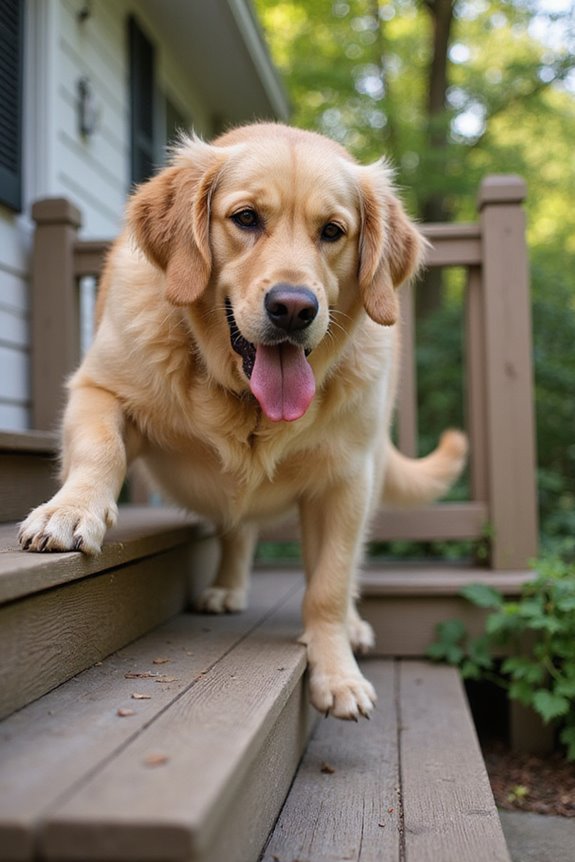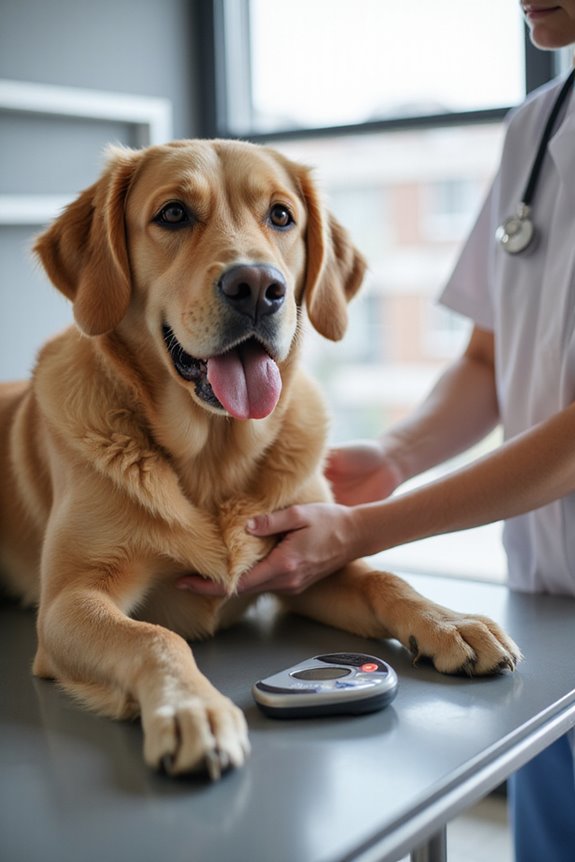To determine if your dog is overweight, look for several signs. Visual indicators include a lack of defined waistline, a sagging abdomen, and fat pads around the hips. Physically, you may notice difficulty in feeling ribs or breathing issues during light activity. Behaviorally, watch for increased irritability, decreased energy, and reduced playfulness. Additionally, mobility issues, such as difficulty climbing stairs, may arise. Understanding these signs is essential for maintaining your dog’s health, so let’s explore more detailed assessments.
Key Takeaways
- Lack of a defined waistline and absence of a tuck from chest to abdomen indicate potential overweight status.
- Difficulty in feeling the ribs due to excess fat suggests your dog may be overweight.
- Noticeable fat pads around the hips and shoulders can be a sign of obesity in dogs.
- Decreased energy levels and breathing issues during light activities indicate possible weight-related problems.
- Behavioral changes, such as increased irritability or reduced playfulness, may also signal weight concerns.
Visual Indicators of Overweight Dogs
When evaluating whether a dog is overweight, visual indicators play an essential role in diagnosing the condition. Observing your dog’s visual silhouette can provide critical insights into their health. Here are key aspects to evaluate:
- Body Shape: A healthy dog has a defined waistline and a slight tuck from chest to abdomen. If you notice a lack of this contour, it may signal excess weight.
- Side View: Overweight dogs exhibit a rounded silhouette, lacking the tapering seen in fit dogs.
- Fat Deposits: Look for noticeable fat pads around the hips and shoulders that can alter their movement.
Confirming visible signs of overweight is essential for making informed decisions about your dog’s health and care.
Physical Signs to Look For

Recognizing physical signs of overweight status in dogs is essential for maintaining their health. As I observe my dog, I look for specific indicators:
- Sagging Abdomen: A noticeable sagging belly, lower than the chest, is common.
- Waist Shape: Healthy dogs should have a subtle waist; if it blends with the chest, it’s a concern.
- Fat Deposits: I check for fat pads between the legs or on the hips, which can alter their movement.
- Rib Palpation: Healthy ribs should feel smooth; excess fat makes them hard to detect.
- Breathing and Energy: If my dog pants during light activity or seems less active than usual, this points to potential overweight status.
Monitoring these physical signs, alongside reviewing their dog diet and exercise routines, is crucial.
Behavioral Changes to Monitor

How can we better understand our dogs’ health through their behavior? As a dog owner, it’s essential to monitor for any behavioral changes that may indicate your dog is overweight. Key signs include:
- Changes in Mood: Overweight dogs often become irritable and may exhibit increased aggression, especially when touched in sensitive areas.
- Playtime Reduction: A noticeable decline in playfulness is common, often due to discomfort. This reduction in activity can lead to boredom and destructive behaviors.
- Decreased Responsiveness: Weight-related discomfort may make your dog less responsive to commands or environmental stimuli.
Recognizing these behavioral shifts early can lead to better health outcomes and help foster a happier, more active life for your furry companion.
Mobility Issues and Their Impact

Mobility issues are a significant concern for overweight dogs, often stemming from the limitations imposed by excess weight. These limitations can lead to a mobility decline, making it difficult for them to rise, walk, or climb stairs. Many heavy dogs experience joint pain, which can be exacerbated by arthritis and inflammation caused by carrying extra pounds.
Reducing weight by just 6% can improve their activity levels, enhancing their quality of life. When dogs struggle to move, they may become less active, creating a cycle of weight gain and health decline. Addressing obesity through weight loss interventions is essential; it alleviates joint discomfort and helps maintain a healthier, happier lifestyle for your beloved companion.
Tactile Assessment Techniques

Tactile assessment techniques are essential tools for dog owners and veterinarians alike, providing a tangible means to evaluate a dog’s body condition and determine if it is overweight.
- Rib Palpation: You should easily feel your dog’s ribs with gentle pressure. If they feel buried under a thick fat layer, it’s a red flag.
- Waistline Check: From above, check for a noticeable inward curve between the ribs and hips. A sagging abdomen indicates excess fat.
- Hip and Tail Base: Palpate the hip bones and tail base. Smooth bones suggest healthy weight, while excess fat creates a padded sensation.
Regular tactile assessments using these palpation techniques can help you detect subtle weight changes, ensuring your dog maintains a healthy body condition.
Understanding Body Condition Scoring
Understanding your dog’s body condition is essential for their overall health, and the Body Condition Scoring (BCS) system provides a standardized approach to assess this aspect effectively.
BCS utilizes either a 1-9 or 1-5 numeric scale to classify body fat and weight status:
- 1-9 Scale: Allows finer distinctions, aiding in identifying subtle weight changes.
- 1-5 Scale: Offers simpler classification but is less sensitive.
For an ideal score, ribs should be easily felt under a slight covering. Higher scores indicate overweight conditions, while lower scores signify emaciation. Observing your dog’s waist from above, checking for an abdominal tuck from the side, and conducting a physical evaluation are essential steps. Regular use of BCS guides appropriate dietary decisions and enhances communication with veterinarians regarding your dog’s health.
Importance of Veterinary Evaluations
While many dog owners may notice changes in their pet’s weight, relying solely on personal observations can be misleading; that’s where veterinary evaluations come into play. A veterinarian’s expertise is essential for effective weight management. They utilize Body Condition Scoring (BCS) systems, which offer an objective assessment of your dog’s weight status. This thorough evaluation includes weight monitoring and checks for underlying health issues that could affect weight and exercise capacity.
Regular veterinary visits also enable personalized weight management plans tailored to your dog’s needs, promoting adherence to dietary and activity recommendations. Additionally, early detection of potential comorbidities helps guarantee your furry friend maintains a healthy, happy life. Consult your veterinarian for informed insights and proactive strategies to support your dog’s well-being.
Health Risks Associated With Obesity
Obesity in dogs poses significant health risks that every pet owner should understand, given that nearly 60% of dogs in North America are classified as overweight or obese. The health consequences of obesity are profound and diverse:
- Reduced Life Expectancy: Obesity can shorten a dog’s lifespan by up to two years.
- Increased Risk of Chronic Diseases: Overweight dogs are more prone to conditions like diabetes, heart disease, and even cancer.
- Orthopedic Problems: Excess weight stresses joints, increasing the risk of osteoarthritis.
- Chronic Inflammation: Obese dogs experience damaging oxidative stress, leading to chronic health issues.
Recognizing these risks underscores the importance of obesity prevention. By prioritizing balanced nutrition and regular exercise, we can enhance our dogs’ quality of life and longevity.
Feeding Habits Contributing to Weight Gain
Many factors influence a dog’s weight, and feeding habits play an essential role in this equation. Free feeding is a common practice, yet it often leads to overconsumption, especially in breeds with high food motivation. Implementing portion control and adhering to a balanced diet composition with lower calorie density can help maintain a healthy weight.
Furthermore, regular feeding frequency—preferably twice daily—ensures dogs receive adequate nourishment without overeating. It’s important to reflect on satiety signals; if dogs aren’t feeling full, they may consume excessive calories. Finally, understanding breed predispositions is significant as some breeds are more prone to weight gain, necessitating careful monitoring and tailored feeding strategies aligned to their specific needs and lifestyles.
Lifestyle Factors Affecting Dog Weight
When evaluating lifestyle factors that affect a dog’s weight, it’s essential to take into account the various influences arising from both owners and their environments. Owner habits considerably matter; those with a sedentary lifestyle tend to exercise their pets less frequently, increasing obesity risks. Income level also plays a role; lower earnings might lead to inadequate dog care, contributing to weight issues.
Urban living can restrict safe outdoor spaces for exercise compared to rural areas. Treat sharing practices, like giving food or snacks from the table, can add excessive calories to a dog’s diet. Additionally, owner awareness is vital; many do not recognize their dog’s obesity, especially as age factors in. Recognizing these lifestyle differences can encourage better management of your pet’s weight.
Frequently Asked Questions
Can a Dog’s Age Affect Its Weight Management?
As time marches on, I’ve noticed age factors can really throw a wrench in weight management. With weight fluctuations becoming more common, I’ve learned to adjust my dog’s diet and exercise for better health.
What Breeds Are More Prone to Obesity?
I’ve learned that breed characteristics play a huge role in obesity risks. Pugs, Beagles, and Golden Retrievers are particularly susceptible. Understanding these traits helps us better care for our furry friends and keep them healthy.
How Can I Encourage My Dog to Exercise More?
To encourage my dog to exercise more, I create fun playtime routines with dog games like fetch or hide-and-seek. It not only keeps them engaged but strengthens our bond, making exercise enjoyable for both of us!
Are There Specific Diets for Overweight Dogs?
Oh, the irony of feeding my dog less while they beg for more! I’ve learned that a balanced diet with careful caloric intake and strict portion control can work wonders for their health and happiness.
How Do I Create a Weight Loss Plan for My Dog?
Creating a weight loss plan for my dog involves carefully managing caloric intake and practicing portion control. I’ll work closely with my vet to guarantee a balanced approach that supports my furry friend’s health and happiness.




